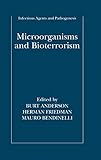Microorganisms and Bioterrorism / edited by Burt Anderson, Herman Friedman, Mauro Bendinelli.
Tipo de material: TextoSeries Infectious Agents and PathogenesisEditor: Boston, MA : Springer US, 2006Descripción: XX, 240 páginas, 14 illus. recurso en líneaTipo de contenido:
TextoSeries Infectious Agents and PathogenesisEditor: Boston, MA : Springer US, 2006Descripción: XX, 240 páginas, 14 illus. recurso en líneaTipo de contenido: - texto
- computadora
- recurso en línea
- 9780387281599
- QR1-502
Springer eBooks
Biotechnology and the Public Health Response to Bioterrorism -- Historical Perspectives of Microbial Bioterrorism -- The Infectious Disease Physician and Microbial Bioterrorism -- Modulation of Innate Immunity to Protect Against Biological Weapon Threat -- Smallpox: Pathogenesis and Host Immune Responses Relevant to Vaccine and Therapeutic Strategies -- Bacillus anthracis: Agent of Bioterror and Disease -- Tularemia Pathogenesis and Immunity -- Brucella and Bioterrorism -- Pneumonic Plague -- Coxiella burnetii, Q Fever, and Bioterrorism -- Genomic and Proteomic Approaches Against Q Fever -- Rickettsia rickettsii and Other Members of the Spotted Fever Group as Potential Bioweapons.
The purpose of this book is to bring together, in a single volume, the most up-to-date information concerning microbes with potential as bioterrorist weapons. The primary audience includes microbiologists, including bacteriologists, virologists and mycologists, in academia, government laboratories and research institutes at the forefront of studies concerning microbes which have potential as bioterrorist weapons, public health physicians and researchers and scientists who must be trained to deal with bioterrorist attacks as well as laboratory investigators who must identify and characterize these microorganisms from the environment and from possibly infected patients.
Para consulta fuera de la UANL se requiere clave de acceso remoto.


